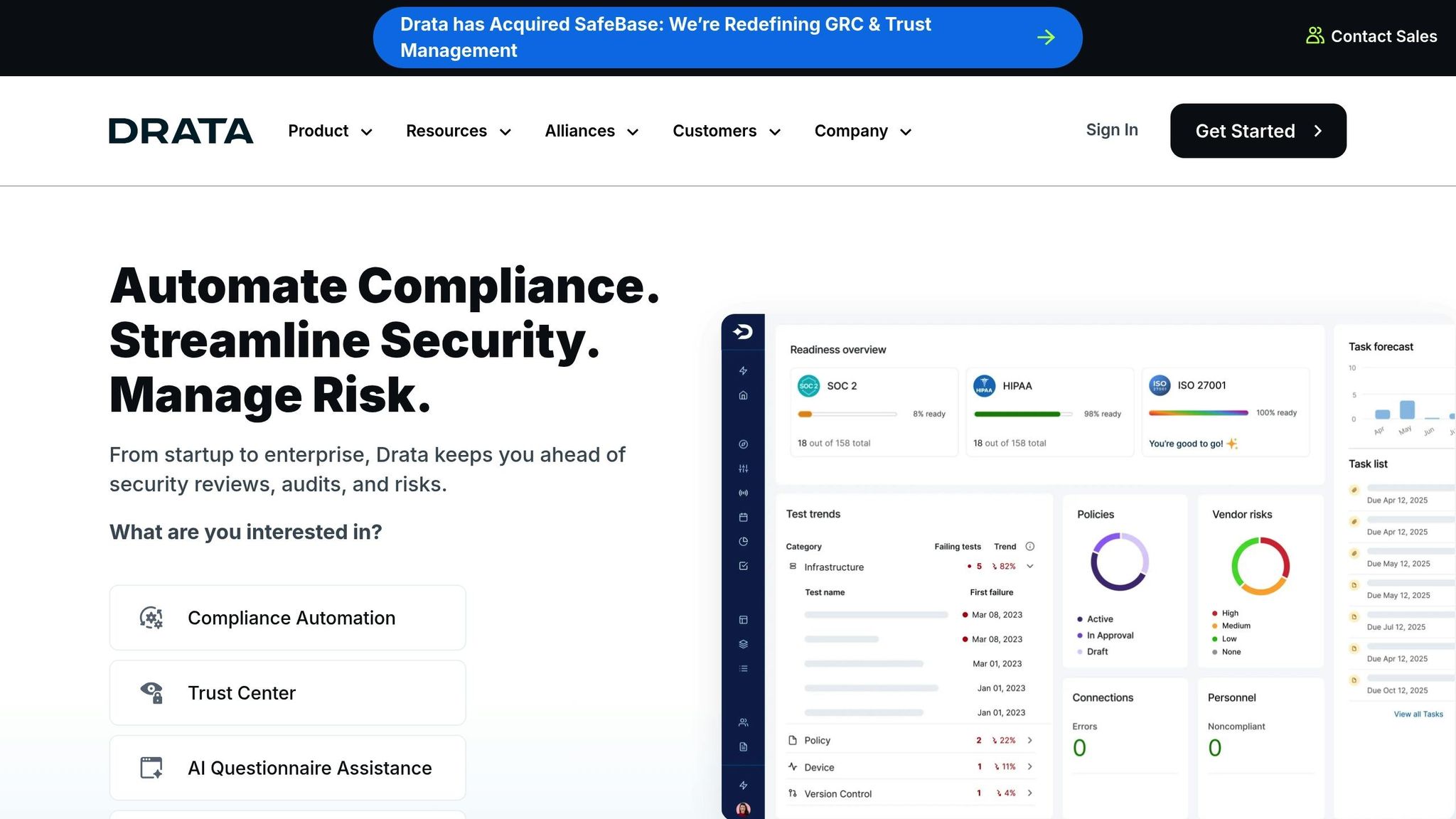Regulatory reporting is a major challenge for startups, but AI tools are making it faster, easier, and more accurate.
AI automates data collection, reduces errors, and keeps reports aligned with the latest regulations. Startups can save time, cut costs, and focus on growth while staying compliant. Key benefits include:
- Time Savings: AI automates repetitive tasks like data entry and report generation.
- Improved Accuracy: Automated checks catch errors and ensure compliance.
- Scalability: AI tools grow with your business, handling more data as you expand.
- Real-Time Updates: Stay compliant with changing regulations automatically.
Manual reporting can lead to costly mistakes, wasted resources, and penalties. AI-powered tools eliminate these risks, making compliance a seamless part of your operations.
Want to know how to get started? Evaluate your current systems, integrate AI tools with your financial software, and test for accuracy. With the right setup, you’ll simplify compliance and free up resources to focus on scaling your business.
Drata: Compliance Automation with AI

Startup Regulatory Reporting Requirements
Startups in the US must navigate a variety of regulatory reporting demands, which depend on their size, industry, and location. Some common requirements include:
- Annual tax filings (e.g., Form 1120 or 1120S)
- Quarterly estimated tax payments
- State-specific business reports
- Payroll tax forms (like Forms 940 and 941)
- Sales tax returns
- Industry-specific reports based on business operations
Challenges of Manual Reporting
Relying on manual processes for regulatory reporting can create significant roadblocks:
- Time-Consuming Data Collection: Gathering data from multiple sources often takes too long and increases the chance of errors.
- Resource Strain: Managing reporting manually pulls valuable resources away from key business activities.
- Version Control Problems: Keeping multiple documents updated consistently can be a logistical headache.
Risks and Penalties of Non-Compliance
Failing to meet reporting obligations can lead to serious consequences, such as:
- Financial Penalties: Late filings or incorrect information can result in costly fines.
- Increased Scrutiny: Missing required documentation may draw unwanted attention from regulators.
- Worsening Issues Over Time: Repeated non-compliance can escalate into legal and operational problems.
Non-compliance doesn’t just hurt financially - it can also damage a startup's reputation with investors, partners, and customers. This could limit growth opportunities. Regulatory investigations often disrupt day-to-day operations and lead to hefty recovery costs, including legal fees and corrective actions.
These challenges highlight the importance of using automated tools to streamline the reporting process.
AI Solutions for Regulatory Reporting
AI has changed the game for startups handling regulatory reporting by automating data processing and cutting down on manual work. These systems not only boost accuracy but also provide real-time insights into financial data.
Automated Data Processing
AI-powered tools connect directly with financial software to turn raw data into clean, standardized reports. This automation reduces manual data entry and errors, speeding up financial management tasks. For instance, Lucid Financials highlights how AI automation helps businesses manage finances faster, allowing them to focus on growth. These systems also lay the groundwork for keeping up with ongoing regulatory changes.
Keeping Up with Regulatory Changes
AI systems take automated data processing a step further by continuously integrating the latest regulations. This ensures compliance efforts stay on track without requiring constant manual updates.
Fewer Errors, Better Compliance
By automating quality checks, AI helps catch and fix mistakes, preventing costly errors. This improved accuracy makes it easier for startups to meet compliance requirements while saving resources that can be redirected toward expansion.
sbb-itb-17e8ec9
Main Advantages of AI Reporting Tools
AI-driven regulatory reporting tools bring a range of benefits to startups navigating compliance challenges. These tools help businesses stay on track while focusing on growth.
Time and Cost Efficiency
AI reporting tools drastically reduce the time spent on compliance tasks by automating data collection and report generation. This frees up teams to focus on initiatives that drive business growth. For example, Lucid Financials simplifies financial management, enabling teams to allocate their efforts toward scaling operations.
Enhanced Accuracy
These tools don't just save time - they also ensure compliance is handled with a high degree of precision. AI systems achieve this level of accuracy through:
- Automated validation: Built-in checks identify and correct inconsistencies before submission.
- Standardized processing: Uniform methods reduce variability in report preparation.
- Real-time monitoring: Continuous tracking ensures reports align with the latest regulations.
By minimizing human error and maintaining consistent standards, AI-powered tools help businesses meet regulatory requirements with confidence.
Scalability for Growth
AI tools are designed to grow with your business. They ensure that as your company expands, regulatory reporting remains efficient and manageable. Key features include:
- Automatic scaling: Easily handle larger data volumes without slowing down.
- Adaptability: Seamlessly integrate new regulatory requirements as your business evolves.
- Strategic insights: Access financial planning tools and industry benchmarks to guide decision-making.
This adaptability makes AI reporting tools an essential resource for startups aiming to scale while staying compliant.
Setting Up AI Reporting Systems
Before diving into AI reporting tools, startups should evaluate their current financial systems to ensure a smooth implementation process.
System Review and Planning
Start by analyzing your existing reporting setup. Look for bottlenecks and areas that consume too many resources, especially when meeting regulatory requirements. Key areas to focus on include:
- Financial data sources and their formats
- Current workflows and reporting timelines
- Compliance challenges and error-prone tasks
- Team capacity and any skill gaps
Develop a transition timeline that prioritizes critical reporting needs, ensuring compliance is maintained throughout the process.
Software Integration Steps
- Connecting Data Sources Link essential financial data sources - like QuickBooks, payroll systems, and banking platforms - to facilitate real-time data flow using tools such as Lucid Financials.
-
Data Mapping and Validation
- Configure custom field mappings for your data.
- Set up rules for data validation.
- Automate reconciliation processes to reduce manual tasks.
- Testing and Verification Conduct parallel testing by running both the old and new systems simultaneously to confirm accuracy and reliability.
Report Quality Control
"Keeping track of my finances used to be overwhelming, but now it's much simpler. The platform is well-organized and easy to navigate."
- Erez Lugashi, Founder and CEO @Abilisense
To ensure high-quality reports, implement these measures:
Scheduled Reviews
- Perform weekly checks on data accuracy.
- Review compliance requirements monthly.
- Assess overall performance quarterly.
System Maintenance
- Stay updated on regulatory changes.
- Schedule regular platform updates.
- Document any system changes.
- Ensure the system stays aligned with AI-driven updates.
Assign a specific team member to oversee system performance and compliance monitoring for consistent results.
Conclusion
Using AI for regulatory reporting is a game-changer for startups. These tools automate tasks like data processing and report creation, ensuring compliance and speeding up financial workflows. This allows founders to focus more on growing their business.
But it’s not just about saving time. As Refael Shamir, Founder and CEO of Letos, puts it:
We found a powerful yet simple solution for our financial planning needs, which has been a great addition to our business.
FAQs
How can AI tools work with existing financial software to make regulatory reporting easier for startups?
AI tools can seamlessly integrate with financial software like QuickBooks, payroll systems, and bank accounts to simplify regulatory reporting for startups. By automating data collection and analysis, these tools reduce manual errors, ensure compliance with regulations, and save valuable time.
For example, platforms like Lucid Financials use AI to provide real-time insights, generate accurate reports, and streamline financial management. This allows startups to focus on growth while ensuring their regulatory obligations are met efficiently.
How does AI help startups stay compliant with ever-changing regulations?
AI-powered tools simplify regulatory reporting for startups by automating complex processes and reducing the risk of human error. These systems can analyze large volumes of data, monitor regulatory updates in real-time, and ensure reports are accurate and compliant with the latest standards.
By using AI, startups can save time, focus on growth, and avoid costly compliance mistakes. For example, platforms like Lucid Financials integrate with financial systems to provide real-time insights and help businesses stay ahead of regulatory changes effortlessly.
How can startups smoothly transition from manual to AI-powered regulatory reporting systems?
Transitioning from manual to AI-powered regulatory reporting can be seamless with the right approach. Start by identifying the specific reporting tasks that consume the most time or are prone to errors. Next, choose an AI-driven platform that integrates with your existing tools, such as accounting software or payroll systems, to ensure a smooth data flow.
Once you've selected a platform, train your team on its features and functionalities to maximize its benefits. Gradually migrate your data, starting with smaller reports to test the system before scaling up. Regularly review the output to ensure accuracy and compliance with regulatory standards. By following these steps, startups can save time, reduce errors, and focus more on growth and innovation.


